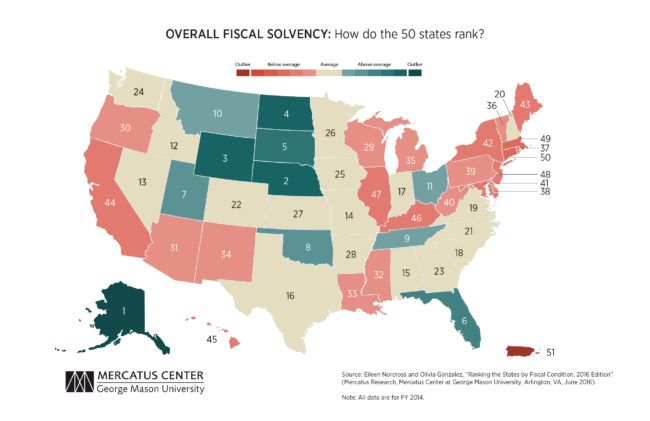Report bolsters governor’s call for budget caution
by Chris Reed | June 6, 2016 7:50 am
 With the June 15 deadline to finalize the 2016-17 state budget looming, Gov. Jerry Brown continues to push back at Democratic lawmakers’ call for him to revise his $123 billion[1] spending plan to include new or expanded spending on social programs. Brown says that the state’s revenue roller-coaster makes such spending risky.
With the June 15 deadline to finalize the 2016-17 state budget looming, Gov. Jerry Brown continues to push back at Democratic lawmakers’ call for him to revise his $123 billion[1] spending plan to include new or expanded spending on social programs. Brown says that the state’s revenue roller-coaster makes such spending risky.
Now the fourth-term governor has new evidence for his case. A comprehensive new report[2] by the Mercatus Center at George Mason University that looked at every state’s audited financial documents from 2014 ranks California 44th in its ability to meet short-term bills and longer term obligations. The report makes the case both for caution on expanding new state spending and for putting as much as possible in the rainy-day fund that voters approved in 2014[3].
In two categories, the Golden State is in the middle of the back.
On budget solvency — which Mercatus defines as “can a state cover its fiscal year spending with current revenues, or does it have a budget shortfall?” — California ranked 23rd.
On service-level solvency — “how much ‘fiscal slack’ does a state have to increase spending if citizens demand more services?” — California ranked 28th.
Long-term picture for California is grim
But in three categories, the Golden State was far worse than the national average, buttressing Brown’s call to beef up the state’s rainy-day fund.
On long-run solvency — “can a state meet its long-term spending commitments? Will there be enough money to cushion it from economic shocks or other long-term fiscal risks?” — California ranked 46th.
On cash solvency — “does a state have enough cash on hand to cover its short-term bills?” — California ranked 47th.
On trust fund solvency — “how much debt does a state have? How large are its unfunded pension and healthcare liabilities?” — California ranked 42nd.
A recent New York Times story[4] about Gov. Brown depicted him as having put California on solid fiscal ground and guided the state’s economy into a “period of prosperity.” The Times account suggested Brown and the Golden State could be a model for national Democrats.
The Mercatus study indicates that this narrative is based on perception more than hard data. Recent U.S. “U-6” unemployment data, which covers not just people without a job but people who work fewer hours than they want, backs up Mercatus. As of August, only six states[5] had more residents unable to find jobs or full-time employment than California.
- $123 billion: http://www.scpr.org/news/2016/05/13/60588/will-brown-s-revised-budget-plan-reflect-more-aust/
- report: http://mercatus.org/sites/default/files/Norcross-Fiscal-Rankings-2-v2_1.pdf
- 2014: https://ballotpedia.org/California_Proposition_2,_Rainy_Day_Budget_Stabilization_Fund_Act_(2014)
- story: http://www.nytimes.com/2016/05/30/us/politics/california-jerry-brown-democrats-primary-hillary-clinton-bernie-sanders.html?_r=0
- six states: http://www.sacbee.com/news/politics-government/capitol-alert/article30714540.html
Source URL: https://calwatchdog.com/2016/06/06/reports-rates-ca-44th-fiscal-health/